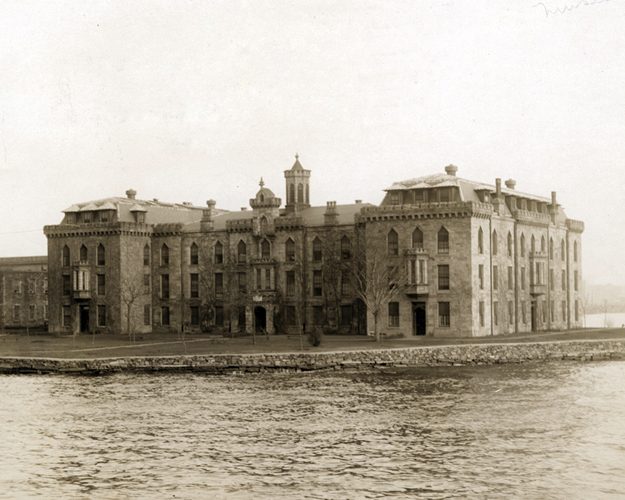The Smallpox Hospital, An Evolving HISTORY
From 1854 until today, the Smallpox Hospital has undergone incredible change in function and scale. Not only did it serve as our country’s first hospital dedicated to the smallpox pandemic of the mid-1800s, it also served as a renowned nursing school. Learn about its evolution below.
ARCHITECT JAMES RENWICK, JR.
James Renwick, Jr., a native of New York City, is considered one of America’s most influential architects. Architect of the Smallpox Hospital, he is also well known for his design of Grace Church and St. Patrick’s Cathedral in New York City and of the Corcoran Gallery of Art and Smithsonian Institution in Washington, DC. Find a further bio here →.
BUILDING EVOLUTION, FROM 1854 TO TODAY
Notable Renwick Buildings
Renwick, Jr. was an architect of buildings across the US. He had an impressive forty-year-long career. Learn more about his buildings here →.
History of the Smallpox Hospital
Compiled from research of New York City and New York State landmark reports and archival press clippings, and with the Roosevelt Island Historical Society.
1828
The City of New York purchases Blackwell Island in the East River as a site for prisons and hospitals.
1850
New York City began vaccinating against the smallpox virus is 1801, but by 1850, due to a large unvaccinated population in New York City, the virus is still responsible for 25.4 out of every 1,000 deaths. According to the State of New York, present accommodations for smallpox victims on Blackwell Island are "but a pile of poor wooden outhouses on the banks of the river."
1854
On April 1, construction of the Smallpox Hospital begins. This will be the first major U.S. hospital dedicated to the care of victims of smallpox. Prisoners of Blackwell Island immediately begin quarrying, cutting, dressing, and laying stone.
1856
On December 18, the Smallpox Hospital is completed, construction costs total $38,000.
1857
The destruction by fire of the old, wooden hospital outhouses makes it necessary to quickly transfer patients to the new hospital building. On January 3, 1857 patients move in.
1875
New York Board of Health assumes control of the Smallpox Hospital and the building is renamed Riverside Hospital and begins to serve a broader community of sick patients.
1886
Riverside Hospital closes and all patients are relocated to hospitals on North Brother Island. Structure, under Thomas S. Brennan, New York City's Commissioner of Charity, is stripped to bare walls, rebuilt and converted to the Home for the Nurses of the Maternity and Charity Hospital Training School.
1895
On June 23, architect James Renwick, Jr. dies.
1903
Wings are added to the building which provide classrooms, dormitories, and training wards to nursing students and staff. Southern wing is completed by York & Sawyer (construction 1903-1904). Northern wing is completed by Renwick, Aspinwall & Owen (construction 1904-1905).
1921
Blackwell Island is renamed Welfare Island.
1956
In the 1950s (possibly 1956), the structure is abandoned. Landfill and debris from ongoing New York City demolition projects begins to be deposited just south of the southernmost wing of the building, due to landfilling, over the course of the next thirty years, Welfare Island will grow in the southern direction by nearly five-acres.
1960
In the 1960s, the structure begins to deteriorate. By the late 1960s, in fact, the building shows extensive water and plaster damage, broken windows and doors, as well as interior debris and vegetation, the roof, however, is intact. Despite decay, the building is included in a list of Welfare Island structures considered worthy of preservation by New York City's Landmarks Preservation Commission.
1970
New York State Urban Development Corporation hires architect Giorgio Cavaglieri to structurally stabilize seven historic landmark structures on Welfare Island. A masonry stabilization project is undertaken by Cavaglieri and includes the stabilization of load-bearing masonry walls and the removal of non-load bearing walls. The roof is removed circa 1971, the hospital shell is now fully exposed to the elements.
1972
On March 16, structure is designated a National Landmark by the National Register of Historic Places.
1973
On September 24, Welfare Island is renamed Franklin D. Roosevelt Island.
1976
On March 23, despite reservations by the New York State Urban Development Corporation, structure is designated a New York City Landmark by the Landmarks Preservation Commission.
1980
The Smallpox Hospital is listed on the New York State Register of Historic Places.
1989
Subway service comes to Franklin D. Roosevelt Island.
1995
In February, Friends of the Roosevelt Island Landmarks, led by Arnold Scaasi and Kitty Carlisle Hart, installs floodlights at base of the structure to illuminate its exterior walls so it is visible at night from the Manhattan shoreline.
1999
Developers propose, for the land surrounding the structure, a hotel and conference center, which would include a five-star restaurant, 350 rooms, 50 condominiums and ferry service that runs to and from the East Side and LaGuardia Airport.
2007
On December 26, winter snowstorm collapses a large section of the northernmost wall of the structure triggering an emergency shoring and bracing of structure.
2015
With an award from New York State Office of Parks, Recreation and Historic Preservation, Walter B. Melvin Architects furthers engineering and structural survey of the building.
2018
Friends of the Ruin, a nonprofit, is established to advocate and raise funds to stabilize the historic building.



